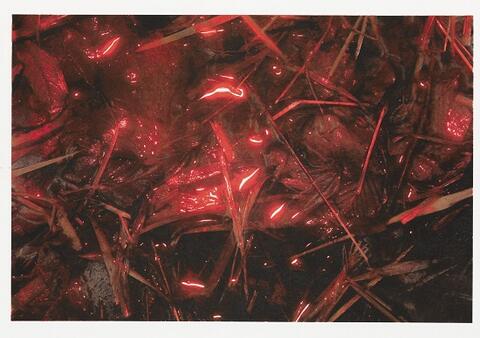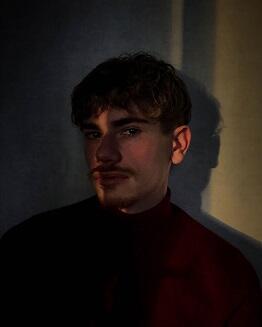
"Unfiltered research": welcome to the world of aquatic beetles
Fine art photographer Grégoire Delanos and researcher Michaël Manuel from the Institute of systematics, evolution and biodiversity laboratory look back on their fascinating collaboration, which began with the photographic project “Unfiltered research”. They explored the world of aquatic beetles together, offering a unique artistic and sensory interpretation.
These photos and those of six other photographers will be on display in the Atrium of the Faculty of Science and Engineering from October 10 to November 4, 2024.
Grégoire, can you tell us about the genesis of your collaboration with Michaël?
Grégoire Delanos: I responded to a call for projects launched by Sorbonne University for a photographic commission to illustrate scientific research. Initially, I work a lot on issues linked to the collapse of biodiversity and climate change. So, when I saw this commission and its "Nature and Environment" section, I thought it was made for me. Michaël's research on dytids—aquatic beetles—and how they perceive their environment via their sensory organs, particularly appealed to me.

How did you approach the idea of representing aquatic beetle research through your photography?
G.D.: I work a lot with photography in an artistic way, that is, using the medium to create compositions linked to the subject. For Michaël's project, I wanted to create a form of synesthesia, where the image would translate the olfactory and gustatory sensations that the predaceous diving beetles might experience.
Although I don't have a background in biology, my artistic approach was nourished by scientific questions. I visited the laboratory with Michaël and his team to understand their research on these diving beetles, and immersed myself in the scientific articles he had passed on to me. The idea was not simply to "document" the science, but to offer a sensory interpretation of it. In particular, I used a front flash with a red filter to capture the atmosphere, energy and sensations that these insects can feel in their environment.
What did you like best about working with a Sorbonne University researcher?
G.D.: I first spent half a day with Michaël and his team in their laboratory, the Institute of Systematics, Evolution and Biodiversity, to familiarize myself with their research work as quickly as possible.
Then, what was really interesting was to be able to go out in the field. Diving beetles are wild creatures, and being able to observe them in their natural environment was a unique experience. It allowed me to discover another facet of scientific work, as we often have a stereotypical image of scientists, in white coats, confined to their laboratories.
Accompanying Michaël in the field, in the middle of the forest, in capricious weather, was a real adventure. It was this exploratory dimension that I particularly enjoyed. And on a more personal level, it was a pleasure to meet Michaël.
Michaël Manuel: Like Grégoire, I was delighted by the experience. It certainly broadened my vision of scientific communication. Working with Grégoire showed me that there are many ways of translating research to make it accessible.
I particularly enjoyed our field day in the Fontainebleau forest, a place I find particularly beautiful. I'm used to working in the field, but sharing this experience with another person, who isn't a scientist, was very interesting. Even if last year's weather conditions made the search for beetles more complex. When we went with Grégoire, there were only small populations...
You've only been able to go once?
M.M.: Yes, it was a one-shot... at least in the Fontainebleau forest! Grégoire had already taken some shots in our insect laboratory.
That said, for this outing, he was more interested in capturing the general atmosphere and light. So I took him to a place that offered a certain diversity: open areas, wetlands, with puddles and pools. It was the environment, the context, that interested him most, not specifically the presence of insects.
Grégoire, what influenced your work on this photo?
G.D.: Many visual artists have inspired me, of course. But above all, I asked myself this question: how can I translate such subtle sensations visually? There had to be a strong dominant color. I chose red, because it's a very organic color, evoking life, energy and strong emotions.
However, during our expedition to the forest of Fontainebleau in February-March, the landscape was dominated by cold, dull hues: the yellow of dead leaves, the brown of mud... I told myself that I had to use a color that contrasted with the natural environment to symbolize the sensory perceptions of the beetles. Red was the ideal choice.
What were the main challenges you faced?
G.D.: The first was athletic! To take the photos, we went for a mountain bike ride in Fontainebleau. That was a challenge in itself!
On a more serious note, for the photo I used a front flash, which creates those characteristic red light effects. The flash produced an intense reflection that I tried to transform into a multitude of iridescences. I concentrated my shots on the edges of ponds, the preferred habitat of diving beetles. By playing with the water droplets on the vegetation, I obtained iridescent red and white reflections.
Finally, the prints were produced in risography by the ChloTour workshop, a successive layer printing technique that allowed me to use three colors: red, black and gold.
Michaël, what attracted you to Grégoire's visual proposal for this interpretation of your research?
M.M.: I've always been interested in insects, especially diving beetles. They are fascinating aquatic insects, both predators and indicators of the quality of their environment.
The aesthetics of Grégoire's photos, with their dominant shades of red and gold, are striking. I find them particularly beautiful. They highlight the often overlooked beauty of these aquatic environments, like these little puddles, rich in biodiversity. It's a whole ecosystem!
Did you give him any elements of your research to help better understand beetles?
M.M.: Yes, that's right. I can't remember exactly when we first met, but I do know that we had the opportunity to discuss his project at length in the laboratory. I was able to present our research to him, show him our facilities and insects.
Then we organized our outing, where he took the photo that was finally selected. And he came back to the lab for more shots. These exchanges were very enriching, as they enabled us to talk in depth about the scientific aspects of our work.
Were there aspects of Grégoire's photography that made you see your research work differently?
M.M.: This experience gave me a lot, far beyond my scientific research. Having never collaborated with an artist before, I was particularly impressed by Grégoire's vision. I still remember the moment when he brought out his colored filters in the field.
I'm used to going out into the field to collect specimens, but this was the first time I'd done it with an artist, which opened up new perspectives. Even though, for the record, we didn't find the large beetles I'd hoped to show him that day, that didn't stop Grégoire from capturing the essence of these environments.
Do you think this photo will help the general public better understand your work and scientific research on the subject of beetles?
M.M.: I certainly hope so! In any case, I'm convinced of the importance of the commentary that will accompany it. Without these explanations, it would be difficult for the public to grasp the link between this image and our research work.
It's always a good thing when scientists step out of the box to share their discoveries with the general public. In concrete terms, this is a real departure from the beaten track, and I think it's an original and effective way of raising awareness of biodiversity and the importance of preserving aquatic environments.

The photo deciphered by Grégoire Delanos
This red, black and gold photograph is printed in risography. This technique, using tiny droplets of ink, is reminiscent of the micro-droplets that attach themselves to the sensory receptors of diving beetles. They perceive their world through these receptors, much as we do with our senses.
The photo, centered on dead leaves and twigs in a humid environment, evokes the environment of the beetles. We see a tangle of more or less organic shapes, with red and white iridescence, representing the sensations of these insects in their environment and the way they move through this mass of vegetation and water.
